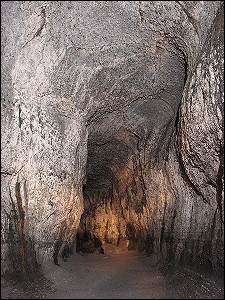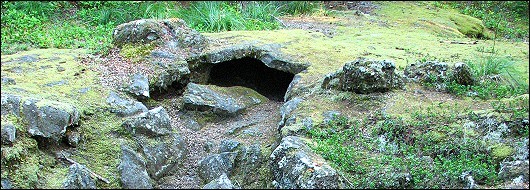Field Trip Overview
Lavatubes of the Mount St. Helens Region
 Everyone is familiar with the fate of Mt. St. Helens on May 18, 1980, but a less celebrated volcanic treasure is less than an hour's drive north of Portland. Some of the largest lava tube caves in the lower 48 states are located here. Ape Cave (3,904 m in length and 7 m tall in places), is the longest and best known, but Ole's, Lake and Little Red River Caves also offer text-book examples of many features. These include multiple lavatube cave styles, other pahoehoe flow-related features such as lava casts of ancients trees, recent lahars and "instant rivers" flowing from the sides of hills. The youth of these tubes (~ 2,000 yrs) is partly the reason that they are so well preserved, as many terrestrial tubes succumb to erosion, seismic activity, or sedimentation. These lavatubes are excellent examples of many features of lavatubes on Earth.
Everyone is familiar with the fate of Mt. St. Helens on May 18, 1980, but a less celebrated volcanic treasure is less than an hour's drive north of Portland. Some of the largest lava tube caves in the lower 48 states are located here. Ape Cave (3,904 m in length and 7 m tall in places), is the longest and best known, but Ole's, Lake and Little Red River Caves also offer text-book examples of many features. These include multiple lavatube cave styles, other pahoehoe flow-related features such as lava casts of ancients trees, recent lahars and "instant rivers" flowing from the sides of hills. The youth of these tubes (~ 2,000 yrs) is partly the reason that they are so well preserved, as many terrestrial tubes succumb to erosion, seismic activity, or sedimentation. These lavatubes are excellent examples of many features of lavatubes on Earth.
The Cave Basalt Flow on the South side of Mt. St. Helens, has numerous, easily accessible examples of lavatubes. Owing to the accessibility of three examples, Lake, Ape, and Little Red River Caves, this Field Guide will not only examine the current state of these features, but cross-reference them with a prior GSA Field Guide from pre-eruptive times, (Hyde and Greeley, 1973). We can see first hand what changes have occurred, and whether they were of natural or anthropogenic origin.
On other planets, lavatubes also appear to exist as revealed by orbital imaging data, especially on the Moon and Mars. Lavatube caves offer particular and special features here on Earth including an amazing diversity of shapes, forms, biology, mineralogy, chemistry and formation mechanisms. The subsurface of Mars, including caves, may have been the last refuge for life on that planet as the climate on the surface became inhospitable. The use of lavatubes on the Moon and Mars as future human habitat has also been suggested.
This field trip will visit Ape and Lake Caves, two of the excellent and varied lavatube caves in the area, receive overview briefings on the volcanic setting of the region, see conspicuous glittering microbial colonies indigenous to lavatubes around the world, and possibly catch glimpses of larger tube inhabitants.


